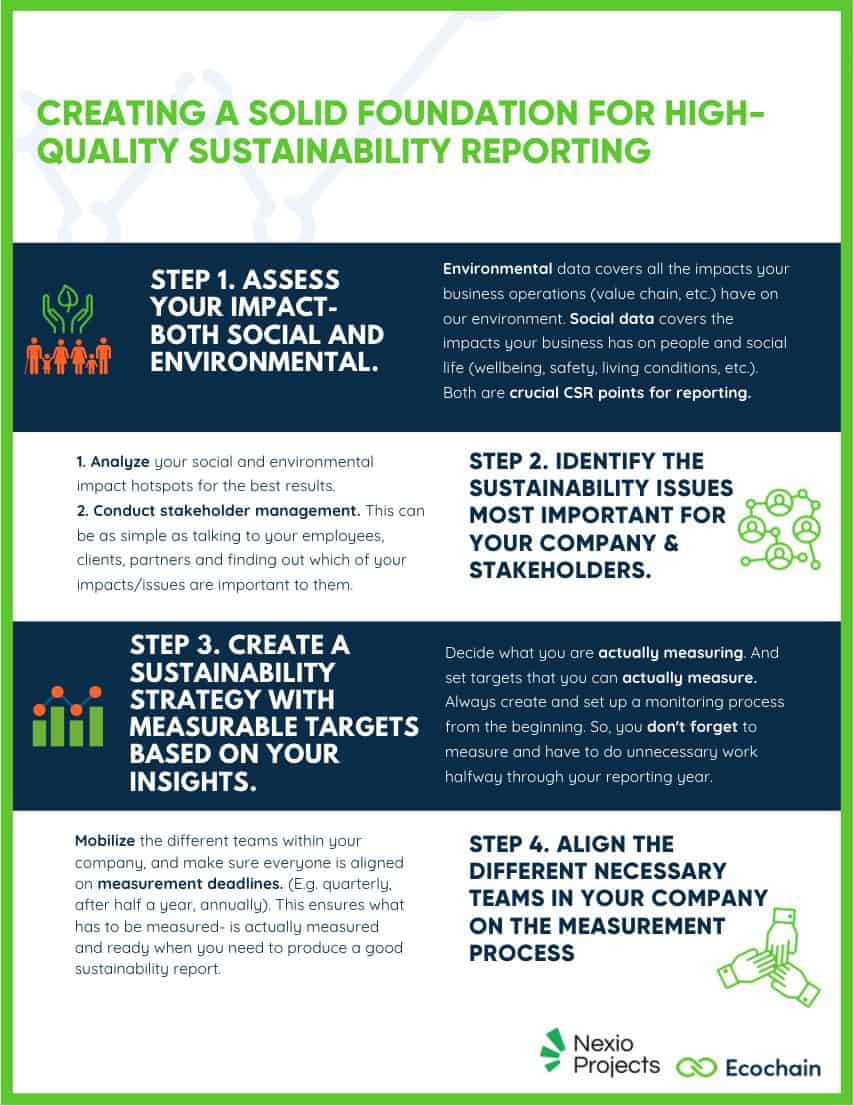Sustainability reporting is no joke. Companies often struggle to collect the right data and create concise and focused reporting on their sustainability matters.
We teamed up with our implementation partner Nexio Projects on how you can tackle that big pool of sustainability data in your company. And turn it into high-quality sustainability reporting.
Step 1. Assess both your social and environmental impact
In reporting, there is often a main focus on the environmental part. But, sustainability includes both social and environmental data. Environmental data covers all the impacts your business operations (value chain, etc.) have on our environment. Social data covers your HR, governance, and other types of impact (well-being, safety, living conditions, etc.) of your business operations on people and social life. Often they even influence each other. Both are crucial CSR points for reporting and should be included in a complete report.
Step 2. Identify which sustainability issues are most important
Not all your results are relevant to put in your report. Identify which impact issues are important for your company and your stakeholders. This includes two things:
1. Analyze your social and environmental impact hotspots
Every company and industry will have different kinds of impacts on the environment. Regardless, you should always focus on your biggest impact hotspots for maximum results. Which environmental impact indicators are most prominent for you? What social considerations really need all your attention?
For example, your biggest environmental impact hotspots could be:
- Greenhouse gas emissions in the customer use phase of your products;
- Land use in your raw material production.
And your biggest social hotspots could be:
- A lack of fair labor practices for workers in your raw material production;
- Low diversity in your workplaces.
2. Conduct stakeholder management
This can be as simple as talking to your employees, clients, and partners – and finding out which of your impacts/issues are important to them. Combining this information with your impact hotspots ensures you make a proper impact. With everybody on board.

Step 3. Create a sustainability strategy with clear measurable targets based on your insights.
With your hotspots and stakeholder engagement results in place – you now decide what you are measuring progress for. And set targets that you can actually measure. Always create and set up a monitoring process from the beginning. This way, you don’t forget you need to measure and have to do unnecessary work halfway through your reporting year e.g. to make sustainability claims.
You can measure sustainability progress on multiple levels:
- Company level: Make a company footprint and aim for scope 1, 2, and 3 measurements. This is usually done according to the GHG Protocol. Our partner Nexio Projects supports our customers with these calculations.
- Supply chain level: Dive into the footprint of your supply/value chain. Which suppliers cause your biggest impact – and offer the biggest impact reduction potential? Generating these insights is usually done by making LCAs of all your products and manufacturing site(s). E.g. by using Ecochain Helix.
- Product/process level: Dive into the footprint of your individual products. Analyze the environmental impact of every detail along their lifecycle – and analyze where you can improve your product’s design and processes. E.g. by using Ecochain Mobius.
Step 4. Align the different teams in your company on the measurement process
You’ll need other people in your company to measure all the relevant data for your sustainability reporting. Mobilize the different teams within your company, and make sure everyone is aligned on measurement deadlines. (e.g. quarterly, after half a year, annually). This ensures that what has to be measured- is actually measured and ready when you need to produce a good sustainability report.
High-quality data is key. Many companies- particularly in big industries, need to understand that they need to create a specific profile to manage the sustainability data. Most of the time they say the facility manager has all the data. But these are two different concepts. To have the data, and to learn how to organize it, clean it, use it.
Cesar Carreño-Chasin, Lead Climate Team at Nexio Projects
Final general reporting tips from Nexio Projects:
1. Use an external reporting platform- e.g. the GRI
This ensures you produce a report that is solid and robust and has everything that a good sustainability report should have.
2. Create a specific job profile for managing your sustainability data
Managing (gathering, cleaning, analyzing, and reporting) sustainability data is a full-time job that many companies underestimate and struggle with.
3. Always use high-quality data
If data is not properly arranged, not high quality, and not properly stored, you can’t do a lot with it. High-quality, well-managed data is the key to reporting processes. It’s a necessity for having really accurate reduction results.
4. Don’t make an endlessly long report
The best kinds of sustainability reports Nexio Projects has seen, are very concise, clear, and to the point. They only cover the most important topics because they create focus in their strategy foundation (hotspots + stakeholder management).

